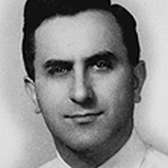
-
Learn More about David
On David Bayer’s 20th birthday, he was working on an irrigation canal with other young Jewish men from the ghetto in his hometown of Kozienice, Poland. When he returned from work, he discovered that everyone, including his parents and siblings, had been taken away in freight cars, headed for the Treblinka killing center. None of his family survived.
Biographical Information
David Bayer was born on September 27, 1922, to Manes and Sarah Bayer in Kozienice, Poland. Manes owned a shoe factory which supplied stores throughout Poland, and Sarah managed the household and helped in the factory. The second of four children in an observant Jewish family, David spent his days going to school, playing sports and working in his father’s factory.
The Germans captured Kozienice on September 9, 1939, eight days after they invaded Poland. During the bombardment, the Bayers hid in a nearby forest. When they returned, they found that most of their possessions—including Sarah’s heirloom Passover dishes—had been destroyed or taken by the German army. The Nazis began to implement antisemitic policies targeting Polish Jews. For example, they confiscated Jewish-owned businesses, and established a curfew. Manes’ factory was seized, and David was arrested for standing in a bread line after curfew had begun. His older sister Rose bribed a guard and secured his release.
In 1942, the Bayers were forced into the Kozienice ghetto. David ended up working as a house boy and translator for a Gestapo officer. He was then put to work on an irrigation canal project. He was at work on September 27, 1942, the day the Kozienice ghetto was liquidated. That day, David’s 20th birthday, the majority of the ghetto’s inhabitants (including the Bayer family) were deported to Treblinka killing center, located in German-occupied Poland, where they were killed. David was smuggled back into Kozienice several days later and worked with a handful of remaining Jews to clean up the ghetto.
In December 1942, the Germans deported the approximately thirty-five Jews left in Kozienice to other nearby ghettos. David was eventually sent to the Pionki labor camp where he was put to work in a factory that manufactured gun powder. There, David was injured in an accidental explosion that burned his face, hands, and feet. In 1944, the Germans sent the prisoners from Pionki to Auschwitz-Birkenau. David was tattooed with the prisoner number “B74.” He was transferred to Neu-Dachs, a subcamp of Auschwitz, where he was forced to work in the Jaworzno coal mines. In January 1945, as the Red Army approached, the Nazis forced the prisoners to evacuate Neu-Dachs on foot. Many prisoners died of cold and starvation on this harrowing death march. After a brief stay at Blechhammer, another subcamp of Auschwitz, David escaped into the forest where he was liberated by Soviet soldiers. He was 23 years old and weighed only 70 lbs.
After his liberation, David made his way to the Foehrenwald displaced persons camp in the American sector of Allied-occupied Germany. In 1947, he first moved to Panama then to Palestine to fight in Israel’s War for Independence (1948). After the war, David returned to Panama and lived there until 1955 when he immigrated to the United States. He settled in the Washington, DC area and owned a liquor store until 1992. David married Adele Abramowitz in 1958 and they had two children. David volunteered at the United States Holocaust Memorial Museum.
